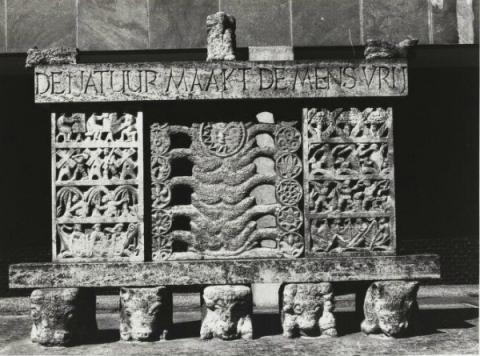Niel Steenbergen
Nature sets humankind free (1977, natural stone)
Simon Building

Steenbergen (1911–1997) studied at the then Kunstnijverheidsschool (School of Arts and Crafts) in Tilburg (1929–1932), the Royal Academy of Fine Arts in Antwerp (1932–1934) and the Rijksakademie in Amsterdam (1935-1938). He owed his first commission, a bust of Jan Adriaanszoon Leeghwater (1937), to the mediation of his teacher Jan Bronner.
In the 1970s, Steenbergen created the sculpture that now stands on the north side of Simon Building. Previously it stood on the other side, when Bedaux's building was still a government office, which housed the Land Registry Office and an annex of the Ministry of Agriculture, among other things. The work of art by Niel Steenbergen, in which a tree stands at the center on a base supported by five pigs, still recalls this function. To the left and right are motifs that refer to the Brabant agriculture and economy: corn sheaves, mills, farmers, leather processors, etc.
Steenbergen was active as a sculptor, medallist, draughtsman, and silversmith. He became a lecturer at the academy in Tilburg where he had studied. He made war memorials, free statues, altars, pulpits, and baptismal fonts, among other things. He made the pontificates (staff, pectoral cross, and ring) for five Dutch bishops and won several awards, including the Prix de Rome for Sculpture in 1938.
More about history and academic heritage
The Tilburg University academic heritage is a very diverse set of archives, visual materials, collections, devices, recorded stories, et cetera that relate to the history of the university.